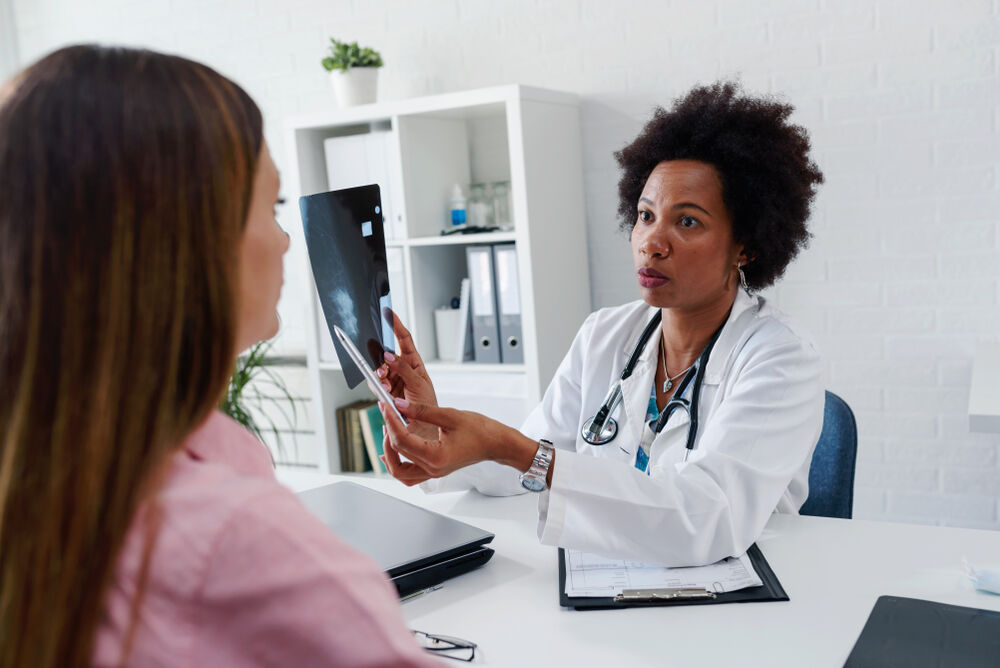ALH to offer mammograms every Saturday in October
Published 10:00 am Saturday, October 8, 2022

- A,Female,Doctor,Sits,At,Her,Desk,And,Talks,To
A mammogram is a low dose x-ray image of a breast used to detect abnormalities and early indicators of breast cancer. They are currently the primary and best tool to use for early detection of breast cancer.
Why routine mammograms are important
The examination allows medical providers to detect cancer at an early stage, prior to a patient feeling ill or experiencing other symptoms, therefore allowing patients to have a greater probability of a positive outcome.
Unfortunately, many women avoid their annual mammogram. Some common causes for avoiding a mammogram are:
- The examination causing physical or social discomfort.
- Being afraid of the results of the examination.
Lack of family history of breast cancer.
Not feeling a lump in self-examinations.
- Believing smaller breasts are less likely to be subject to breast cancer.
Concerns regarding radiation exposure.
- Believing they are too young or too healthy to have breast cancer.
- The primary care provider failed to order one.
- Believing mammograms are overly fallible.
Many women are concerned by radiation exposure during a mammogram. A mammogram exposes the breasts to a small amount of radiation, less than what you would be exposed to naturally in a year with background radiation.
The dose of radiation used for a screening mammogram of both breasts is about the same amount of radiation a woman would get from her natural surroundings over about 7 weeks.
On average the total dose for a typical mammogram with 2 views of each breast is about 0.4 millisieverts, or mSv. The radiation dose from 3D mammograms can range from slightly lower to slightly higher than that from standard 2D mammograms.
Many women find the compression of their breasts during a mammogram to be a deterrent for the annual screening.
Compressing the breasts hold them in place, minimizing the impact and blurring of patient motion. Compression evens out the shape of the breast so that the x-rays can travel through a shorter path to reach the detector. The breasts being flattened out reduces the amount of radiation necessary to create an image. Compression allows all the tissues to be visualized in a single plane so that small abnormalities are less likely to be obscured by overlying breast tissue.
Benefits of receiving a routine mammogram:
- Risk of fatality is reduced by approximately 30 percent with early detection.
- Mammograms can detect abnormal breast tissue approximately two years before it becomes cancerous.
- Mammograms improve your chances of breast conservation. Early detection of localized breast cancer lowers your chances of needing a mastectomy.
Currently, women should begin having annual mammograms once they turn 40 years old if they have no prior history of cancer in themselves or family members. If the patient has a cancer history, they could benefit from beginning the annual screening at an earlier age.
As a woman ages, her risk for developing breast cancer increases. Women under 40 have less of a likelihood of developing breast cancer, but it is not uncommon. Women under 40 should also be aware of the signs and symptoms of breast cancer and perform routine self-examinations.
According to the CDC, some warning signs of breast cancer are:
- New lump in the breast or underarm (armpit).
- Thickening or swelling of part of the breast.
- Irritation or dimpling of breast skin.
- Redness or flaky skin in the nipple area or the breast.
- Pulling in of the nipple or pain in the nipple area.
- Nipple discharge other than breast milk, including blood.
- Any change in the size or the shape of the breast.
- Pain in any area of the breast.
These symptoms can indicate conditions other than cancer, as well, and a patient should seek advice from a healthcare provider if they suspect illness.
While having a routine mammogram can mitigate the risks of breast cancer, the screening has other benefits, as well.
Routine mammograms provide your doctor with an ongoing record of your breasts that can be used for comparison in subsequent years. These records could be useful in spotting tiny aberrations in tissue that could indicate an early stage of cancer.
The day of your mammogram
What you need to know going into a mammogram, according to the FDA:
- Don’t wear deodorant, perfume, lotion or powder under your arms or on your breasts on the day of your exam. Foreign particles could show up in an x-ray.
- Let the staff know if you have breast implants. They may need to take more pictures than a regular mammogram.
- Bring prior mammograms or have them sent to the center if possible.
- Tell the clinic if you have physical disabilities that may make it hard for you to sit up, lift your arms, or hold your breath.
The screening is done with a machine that is designed to only look at the breast tissue. The machine takes x-rays at lower doses than the x-rays used for other parts of the body. For a 2D mammogram, the machine has 2 plates that compress or flatten the breast to spread the tissue apart. This gives a better quality picture and allows less radiation to be used.
A 3D mammogram known as a breast tomosynthesis or digital breast tomosynthesis, takes multiple low-dose x-rays as it moves in a small arc around the breast. A computer then splices the images together into a series of thin slices. The image allows doctors to see the breast tissues more clearly in three dimensions. A 2D mammogram can be taken at the same time, or it can be reconstructed from the 3D mammogram images.
Studies have shown that 3D mammograms are especially helpful for women who have dense breasts. It also reduces the chances of being called back for a second screening and may detect more types of breast cancer.
Receiving your results
After the screening is complete, a radiologist will examine the image for abnormalities such as calcifications, masses, asymmetries, architectural distortion, and breast density.
Calcifications are tiny calcium deposits within the breast tissue, which may or may not be caused by cancer. They look like small white spots on a mammogram.
Macrocalcifications are more common as women age. They are larger calcium deposits caused by the aging of the breast arteries, old injuries, or inflammation. These deposits are typically related to non-cancerous conditions and don’t need further testing with a biopsy.
Microcalcifications are tiny specks of calcium in the breast. They are more of a concern than macrocalcifications, but don’t always mean that cancer is present.
In most cases, microcalcifications don’t need to be checked with a biopsy.
A mass is an area of abnormal breast tissue with a shape and edges that make it look different than the rest of the breast tissue on a mammogram.
Asymmetries are white areas seen on a mammogram that look different from the normal breast tissue pattern.
All information was pulled from the U.S. Food and Drug Administration, American Cancer Society, Center for Disease Control and Prevention, and the National Institute of Biomedical Imaging and Bioengineering.
Early detection is key to achieving positive outcomes with a breast cancer diagnosis and failing to receive your annual mammogram could have fatal consequences.
For Breast Cancer Awareness month, the Athens-Limestone Hospital is offering mammograms every Saturday in October.
“Athens Limestone Hospital is pleased to offer Screening mammograms each Saturday during the month of October at the Limestone Medical Village/Medical East facility during hours of 9:00 am to 3:00 pm,” said Charlotte Perkins, Imaging Director at ALH. “Annual mammogram screening is a vital tool in detecting breast cancer in its earliest stages. The goal is to find breast cancer before a woman notices any symptoms.”
She went on to explain, “the earlier a malignancy is detected, the better the chances of curing the disease before it spreads throughout the body and requires more invasive therapies. Women who have breast cancer detected in the early stages may have up to a 98 percent chance of survival.”
To schedule an appointment, call (256)-216-9696.





